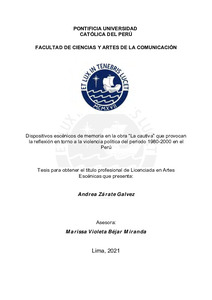| dc.contributor.advisor | Béjar Miranda, Marissa Violeta | |
| dc.contributor.author | Zárate Galvez, Andrea | |
| dc.date.accessioned | 2021-12-18T01:47:11Z | |
| dc.date.available | 2021-12-18T01:47:11Z | |
| dc.date.created | 2021 | |
| dc.date.issued | 2021-12-17 | |
| dc.identifier.uri | http://hdl.handle.net/20.500.12404/21209 | |
| dc.description.abstract | La presente tesis plantea una aproximación desde las comunicaciones y las artes
escénicas al estudio de los dispositivos escénicos de memoria en la obra La cautiva, estrenada
en el Teatro La Plaza (2014) y su impacto en un público sensible al tema que representa. Por
un lado, se analizan los elementos escénicos del montaje, trabajados por la dramaturgia y la
dirección artística (texto dramático, personajes, actuación, escenografía, iluminación, música
y sonido), mientras que, por otro lado, se analizan la reflexión y el diálogo que surgen en un
público escogido, luego de haber sido espectadores de la videograbación de la obra, desde la
virtualidad, en 2020. La población seleccionada para visualizar La cautiva son hijos e hijas de
miembros retirados de las Fuerzas Armadas y Policiales, que estuvieron en servicio durante el
periodo de violencia política 1980-2000, en el Perú. La obra teatral La cautiva toca el tema del
abuso sexual de un militar al cuerpo de una adolescente, hija de militantes del grupo terrorista
Sendero Luminoso, responsables de haber cometido atentados terroristas en la década de 1980.
Las principales conclusiones de esta investigación son que la obra La cautiva, contiene
dispositivos escénicos de memoria al vincular a los espectadores con una memoria colectiva
que entraña conflictos y tensiones aún no resueltas en la sociedad peruana, incluso seis años
después de su estreno; así como, brinda la posibilidad del encuentro, de fomentar el respeto a
la mirada del otro y de crear puentes de diálogo entre diferentes puntos de vista. | es_ES |
| dc.description.abstract | This thesis proposes an approach from the point of view of the disciplines of
communications and the performing arts to the study of theatrical memory devices used in the
play La cautiva, premiered at the Teatro La Plaza (2014), as well as its impact on an audience
sensitive to the theme it represents. On the one hand, this thesis analyses the theatrical elements
of the play- dramatic text, characters, elaborated by the playwright; and acting, scenery,
lighting, music and sound worked by the artistic director. On the other hand, the reflection and
dialogue that arise in a chosen audience, after having been spectators of the video recording of
the play virtually in 2020, are also studied. The population selected to watch La cautiva are
sons and daughters of retired members of the Armed Forces and Police of Peru, who were in
service during the period of political violence in 1980-2000. The play La cautiva talks about
the sexual abuse committed by a soldier over the dead body of a teenager who was the daughter
of militants of the Shining Path terrorist group. The Shining Path is known to be responsible
for having committed terrorist attacks during the 1980s and 1990s. The main conclusions of
this research are that the play La cautiva, contains theatrical memory devices to engage viewers
with a collective memory that involves conflicts and tensions still not resolved in Peruvian
society; as well as, even six years after its release, it gives the possibility of connecting people,
to encourage respect on others’ perspective and build bridges of dialogue between different
points of view.
Keywords: | es_ES |
| dc.language.iso | spa | es_ES |
| dc.publisher | Pontificia Universidad Católica del Perú | es_ES |
| dc.rights | info:eu-repo/semantics/openAccess | es_ES |
| dc.rights.uri | http://creativecommons.org/licenses/by-nc-sa/2.5/pe/ | * |
| dc.subject | Violencia política--Perú | es_ES |
| dc.subject | Terrorismo--Perú | es_ES |
| dc.subject | Teatro--Perú | es_ES |
| dc.title | Dispositivos escénicos de memoria en la obra “La cautiva” que provocan la reflexión en torno a la violencia política del periodo 1980-2000 en el Perú | es_ES |
| dc.type | info:eu-repo/semantics/bachelorThesis | es_ES |
| thesis.degree.name | Licenciado en Artes Escénicas | es_ES |
| thesis.degree.level | Título Profesional | es_ES |
| thesis.degree.grantor | Pontificia Universidad Católica del Perú. Facultad de Ciencias y Artes de la Comunicación. | es_ES |
| thesis.degree.discipline | Artes Escénicas | es_ES |
| renati.advisor.dni | 07207206 | |
| renati.advisor.orcid | https://orcid.org/0000-0001-8265-4523 | es_ES |
| renati.author.dni | 47216281 | |
| renati.discipline | 215046 | es_ES |
| renati.juror | Rubina Vargas, Celia Isabel | es_ES |
| renati.juror | Béjar Miranda, Marissa Violeta | es_ES |
| renati.juror | Jave Pinedo, Iris | es_ES |
| renati.level | https://purl.org/pe-repo/renati/level#tituloProfesional | es_ES |
| renati.type | https://purl.org/pe-repo/renati/type#tesis | es_ES |
| dc.publisher.country | PE | es_ES |
| dc.subject.ocde | https://purl.org/pe-repo/ocde/ford#5.08.00 | es_ES |






